Week 6: Nonvascular Plants and Seedless Vascular Plants
Objectives
- Distinguish members of Kingdom Plantae from their nearest relatives (charophyte algae)
- Draw a basic phylogeny for Kingdom Plantae
- Diagram and explain the life cycle of plants (alteration of generations)
- Differentiate the characteristics of nonvascular plants versus seedless vascular plants
- Using images, explain the life cycles of moss (a nonvascular plant) and ferns (a seedless vascular plant)
This lab begins with an introduction to Kingdom Plantae and then continues by focusing first on nonvascular plants, such as mosses, and then on seedless vascular plants, such as ferns.
- 1. Kingdom Plantae: Origin and Phylogeny
- II. Nonvascular Seedless Plants
- III. Seedless Vascular Plants
- IV. Post-lab Questions
This lab includes the following diagrams to be printed out and labeled.
I. Kingdom Plantae: Origin and Phylogeny
Plants evolved from green algae (Supergroup Archaeplastida) approximately 470–480 million years ago. The nearest living relatives of the plant kingdom are a group of green algae called charophyceans or charophytes (Phylum Charophyta). A common charophyte is the stonewort. There are over 700 species of charophytes, most of which live in fresh water habitats such as ponds and streams (see Figures 1A and 1B).
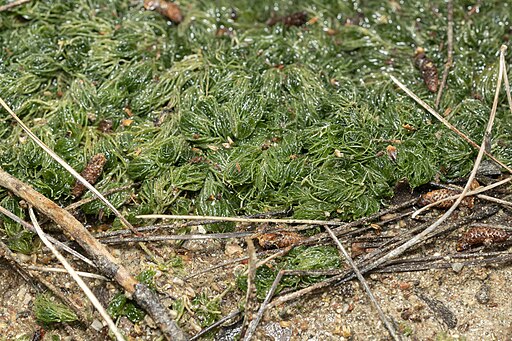

Activity 1: Overview of Plant Classification
Plants can be classified into three basic groups: nonvascular plants, seedless vascular plants, and seed plants. Find each of these groups in Figure 2 below.
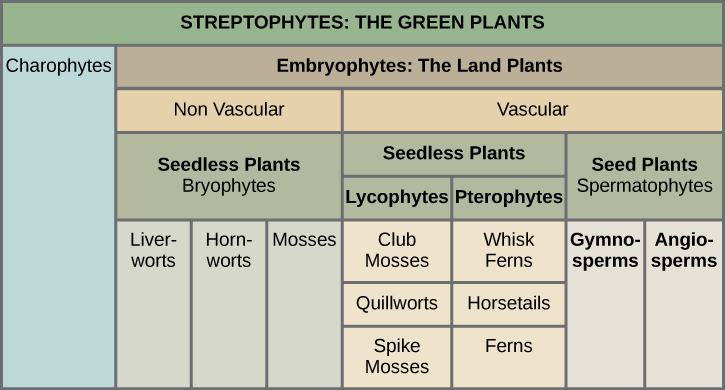
Your instructor may ask you to review “Reading: Seedless Plants” before coming to lab. You will also find links to this reading in the paragraph below on plant classification.
Plant taxonomy
Fill in a table like the one below, using the information from “Reading: Seedless Plants” (scroll down to the table in the section labeled “Classification”). This will tell you the names of the phyla in each group, as well as the common names for each phylum. To find the characteristics, read “Bryophytes” for nonvascular plants and “Seedless Vascular Plants” for seedless vascular plants. If you cannot find information for each subgroup, that is OK—just be sure to include characteristics for each of the following groups: nonvascular plants, seedless vascular plants, seed plants, gymnosperms, and angiosperms. The first one is done for you as an example.
| For each group, list the PHYLUM names in the blank spaces. | Give the common name for each phylum you listed. | List 1–2 characteristics for each group in the chart. |
| I. Nonvascular plants (Bryophytes) | ||
| 1. Phylum Hepatophyta | Liverworts | No seeds, no vascular tissue, flat, lobed thallus (leaflike structures), gemma cups for asexual reproduction, gametophyte dominant, flagellated sperm |
| 2. | ||
| 3. | ||
| II. Vascular Plants | ||
| Seedless Vascular Plants | ||
| 1. | ||
| 2. | ||
| Seed Plants | ||
| A. Gymnosperms | ||
| 1. | ||
| 2. | ||
| 3. | ||
| 4. | ||
| B. Angiosperms | ||
| 1. |
Plant kingdom phylogeny
To show the evolutionary relationships of the major plant groups, we can create a phylogenetic tree, as you have done in earlier labs. For those trees, you used DNA evidence. This week, you will use the characteristics from the table you completed above to determine relatedness and then construct a tree. Your tree should include the following groups: nonvascular plants, seedless vascular plants, seed plants, gymnosperms, angiosperms, monocots, and eudicots.
Activity 2: Alternation of Generations
Before lab, watch the following video for an explanation of the “alternation of generations” life cycle if you need a review. You don’t need to watch the first half of the video—you can start watching at 4:12 and continue to the end (about five minutes total). Refer to Figure 3 (below) as you watch, relating the explanations in the video to the diagram.
Study Figure 3 below, which depicts the general life cycle of plants. As you may know, plants have a life cycle that alternates between a haploid stage, called the gametophyte, and a diploid stage called the sporophyte. For most plants, we usually see only the sporophyte stage. The gametophyte stage is often tiny and contained deep inside the tissues of the sporophyte stage. Understanding this life cycle is an important tool for understanding the evolution and classification of plants.

Now play “Alternation of Generations,” a game testing your knowledge of the life cycle of plants. IMPORTANT: Click on the triangular play button on the diagram. Do not click on other buttons labeled “start” or “download”—these are ads trying to add an extension to your browser (and it can be hard to remove it). The game should take you about 5–10 minutes. See how fast you can get all the answers correct! Take a screenshot of your best time and paste it into your lab report.
Activity 3: Life Cycle of the Moss
Watch the video “Examine metagenesis and the roles of antheridia, archegonia, and the sporangium in the moss Mnium hornum.” Afterward, download and print out a copy of Figure 4 and then label the diagram using the following terms: gametophyte, sporophyte, capsule, spores, germination, protonema, antheridia, archegonia, and fertilization. Note that not all terms correspond to one of the numbers 1–6 in the diagram..
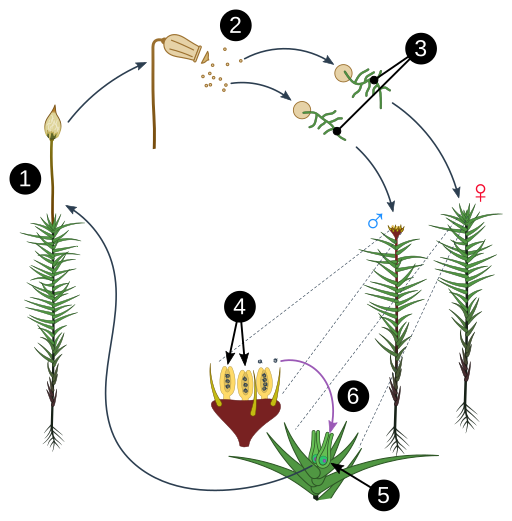
Key Terms
| Term | Definition |
| Alternation of generations | A life cycle that includes a haploid stage alternating with a diploid stage, found in plants, in many multicellular algae, and even in some fungi and animals |
| Sporophyte | The multicellular, diploid stage of the life cycle that produces haploid spores by meiosis |
| Gametophyte | The multicellular, haploid stage of the life cycle that produces haploid gametes by mitosis |
| Sporangium | Tissue or organ that produces spores (plural: sporangia) |
| Gametangium | Tissue or organ that produces gametes (plural: gametangia) |
| Archegonium | Refers to the female, egg-producing gametangium in multicellular algae and seedless plants |
| Antheridium | Refers to the male, sperm-producing gametangium in multicellular algae and seedless plants |
| Spore | A unicellular, haploid reproductive structure that germinates to produce the next stage of the life cycle by mitosis (without fertilization). May be surrounded by a protective coating; often capable of dispersion. |
| Germination | Mitotic growth of a reproductive structure, such as a seed or a spore, after a period of suspended metabolic activity |
| Gamete | Haploid cell that must fuse with another gamete during fertilization to produce a zygote |
| Zygote | A single, diploid cell produced by the fusion of two gametes during fertilization |
| Meristem | Plant tissue that divides continuously to produce undifferentiated stem cells (and thus, growth) throughout life |
| Vascular tissue | Plant tissue in most plants that allows efficient transport of water, nutrients, and other substances |
II. Nonvascular Seedless Plants
Before lab, review “Seedless Plants Bio II Slides,” which highlights the characteristics of nonvascular and seedless vascular plants.
This week we are focusing on nonvascular plants and seedless vascular plants. A familiar example of a nonvascular plant is moss, such as the plant shown in Figure 5 below.
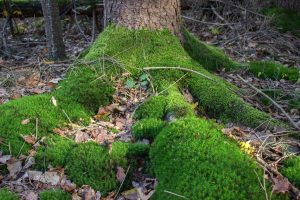
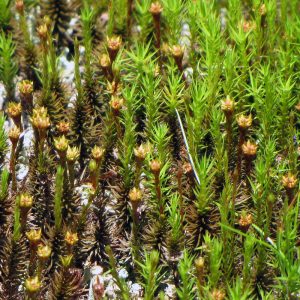
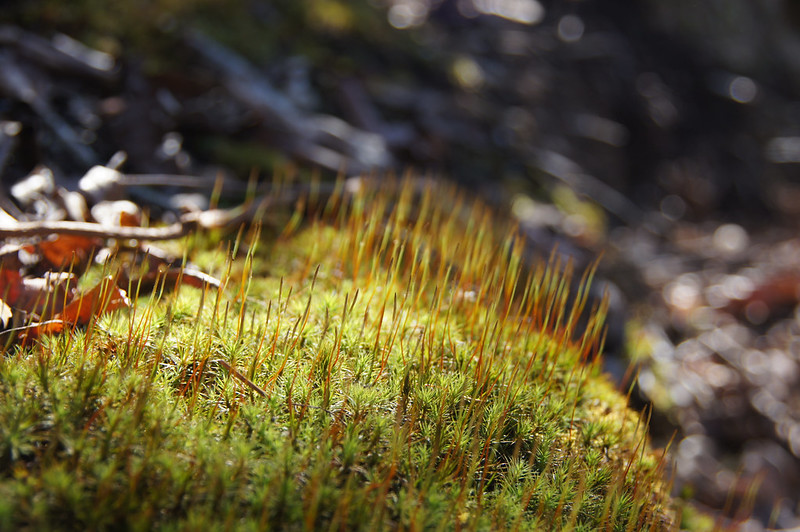
Activity 4: Microscopic Survey of Nonvascular Seedless Plants
Observation of prepared slides—Bryophytes
Proceed to the demonstration table to obtain the prepared slides of the Bryophytes listed below. Please, perform microscopy observations, and write your observations in your lab notebook.
- Phylum Hepatophyta: Liverworts (slides)
- Marchantia antheridia
- Marchantia archegonia
- Marchantia sporophyte
- Phylum Bryophyta: Moses and Polytrichum (slides)
- Moss antheridia
- Moss archegonial
- Moss sporangium (capsule)
- Moss protonema
Answer the following questions (many of which are adapted from the source attributed below).
1. What are the characteristics of nonvascular plants?
2. As indicated in the reading, use the space below to draw a simple life cycle of the moss. Include in the life cycle 2N, N, sporophyte, gametophyte, meiosis, spores, egg, sperm, antheridium, archegonium, and fertilization.
3. View the prepared slide of the archegonium and the antheridium. Is the archegonium male or female?
4. What cell is produced in the archegonium?
5. Is this cell haploid or diploid?<
6. Is the antheridium male or female?
7. What cell is produced in the antheridium?
8. Is this cell haploid or diploid?
9. View the prepared slide of the moss capsule. Is the capsule sporophyte or gametophyte tissue?
10. What cell is produced in the capsule?
11. Is this cell haploid or diploid?
12. How are moss spores dispersed to new locations?
Making a wet mount of Chara or Nitella
On your lab bench, you will find the following materials:
- glass slides
- cover slips
- lens paper
- dropper bottle of water
- dissecting needle
To prepare a wet mount:
- Obtain a clean slide and draw a circle using the red pencil provided.
- Use the forceps or dissecting needle to remove a piece of the Chara or Nitella.
- Place the Chara or Nitella sample into the middle of the circle that you have drawn.
- Use the Pasteur pipette, and place a small drop of water onto the sample.
- Make sure that the water is evenly spread over the sample.
- Once your sample is completely covered, gently place the coverslip over the top of the sample avoiding any air bubbles.
- Observe your newly prepared wet mount under the microscope and record your findings in the lab notebook.
Answer the following questions (adapted from the source attributed below).
1. View the live moss specimens available in the lab. Is the green “leaf-like” tissue gametophyte or sporophyte?
2. Is the stalk that emerges from the green “leaf like” tissue gametophyte or sporophyte?
III. Seedless Vascular Plants
Before lab, read the information on the seedless vascular plants in “Seedless Vascular Plants.” and review “Seedless Plants Bio II Slides.”
A familiar example of a seedless vascular plant is a fern, such as the plant shown in Figure 6 below.
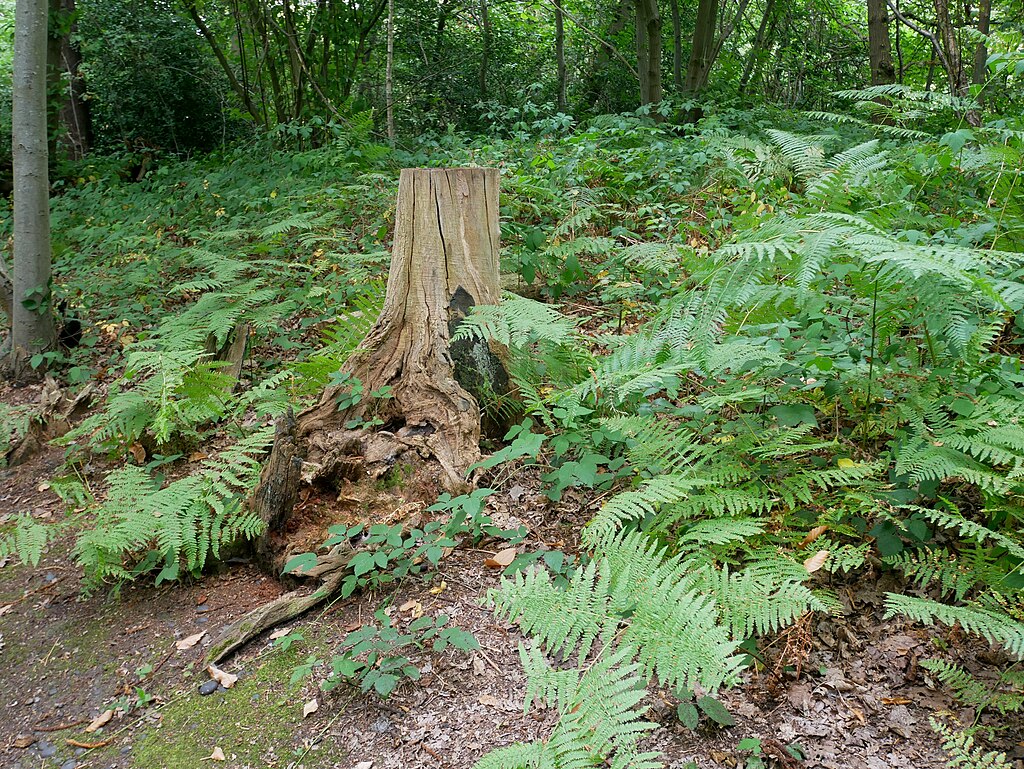
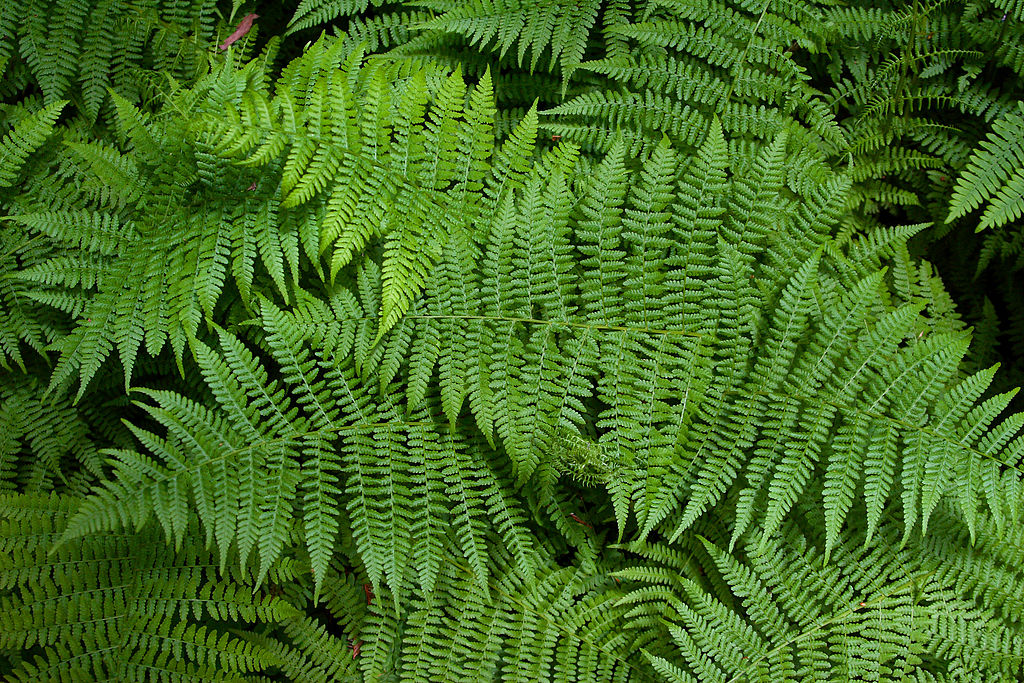
Activity 5: Microscopic Survey of Seedless Vascular Plants
Proceed to the demonstration table to obtain the prepared slides of the Lycophytes and the Pterophytes listed below. Please, perform microscopy observations, and write your observations in your lab notebook.
- Phylum Monilophyta:
- Subphylum Sphenophyta: Horsetails
- Equisetum (living plant)
- Equisetum (slide)
- Subphylum Pterophyta:
- Fern slides
- cycle
- prothallium
- sporophyte
- Fern slides
- Subphylum Sphenophyta: Horsetails
Answer the following questions. Use “Seedless Plants Bio II Slides” for help. (Questions are adapted from the source attributed below).
1. What are the characteristics of seedless vascular plants?
2. Draw a simple life cycle of the fern. Include in the life cycle 2N, N, sporophyte, gametophyte, meiosis, spores, egg, sperm, antheridium, archegonium, fertilization, and sorus.
3. Observe the preserved fern frond. Locate the sori on the underside. Is the frond sporophyte or gametophyte?
4. What cell is produced in the sori?
5. Is this cell diploid or haploid?
6. View the prepared slide of the fern prothallus under the microscope. What shape is the prothallus?
7. Is the prothallus sporophyte or gametophyte?
8. Can you find the archegonium and the antheridium?
9. What cell is made in the archegonium?
10. What cell is made in the antheridium?
IV. Post-lab Questions
To complete this lab and summarize what you have learned, please answer the following questions.
1. Visit the interactive fern life cycle at Science Learning Lab and use the interactive tool explaining the life cycle of a fern. Click on each label to see the details of each stage and each structure. Afterward, download and print out a copy of Figure 7 and then label the diagram by indicating the correct structure or phase of the life cycle for all of the following terms: sporophyte, gametophyte, spores, germination, rhizoids, sorus, frond, archegonium, antheridium.
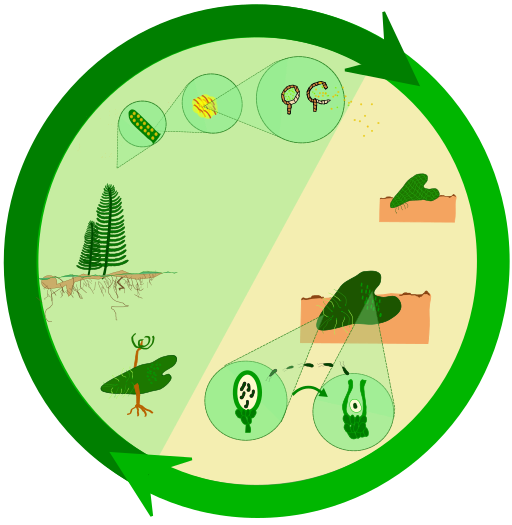
2. Is gametophyte tissue haploid or diploid?
3. Is sporophyte tissue haploid or diploid?
4. Is the moss life cycle gametophyte or sporophyte dominant?
5. Is the fern life cycle gametophyte or sporophyte dominant?
6. In the life cycle of the primitive plant, the process of meiosis produces what cell?
7. Does the gametophyte or sporophyte generation produce spores?
8. What process do spores undergo to create sperm and egg?
9. State one reason why moss and fern are considered primitive plants.
10. What is meant by the idea of “alteration of generations?”
Attribution
Questions in this lab are adapted from “4.1: Seedless Plant Lab” by Lynette Hauser, licensed CC BY 4.0.
